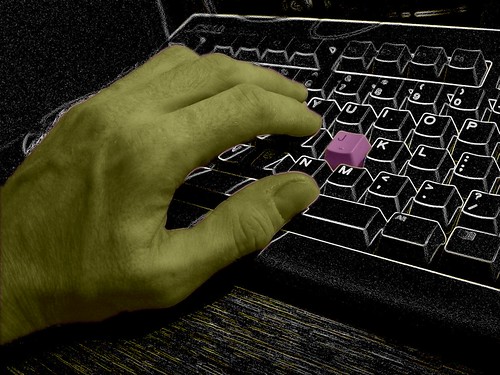 |
| image by zsoolt |
Some time ago I interviewed people as part of my PhD and I was very lucky to talk to a young woman whose story and insights are revealing for anyone who has had hair pulling disorder. Here is the interview...
"I can't remember the first time [I pulled my hair]
specifically. However, I do remember the first few months of the
behaviour. Most of the time I was in bed or on a couch, just sitting
there and pulling the hair out of my head. When I was five I began
skin picking on my head specifically...nothing that I can recall really triggered the
beginning of it, I guess I was just an anxious little girl. It was
definitely calming for me though, that's the main feeling I
recall.
Pulling was first directed towards my head, then later on towards pubic hair but
still mostly my head hair. Then the behaviour went away for the most
part and now I will occasionally pull eyebrow hair but not nearly to
the extent I used to."
The interviewee was asked to consider a range of possible environmental factors that may have contributed to her hair pulling, with the emphasis on feeling trapped, isolated or confined. Here is what she said:
"I was abused by someone a little older than me who used to ride his bike around our neighborhood, and because I
was afraid of him I spent the majority of my childhood hiding inside,
even after he moved away. Therefore, I did feel confined. I also felt abandoned by my parents, specifically by my
mother, because the first time my abuser babysat me, I told them I
didn't want him over because I was scared of him and they left anyway.
Sadly, the clearest picture I remember during that part of my life is
looking out the window and seeing them drive away."
What other factors might have contributed to the hair pulling?
"As far as
environmental factors, when I was 11 my mother bought me a large,
lighted magnifying mirror for my skin or something. This is when I
would lock myself in my bathroom for hours picking at my face. For
hair pulling, I can't really think of any but I know my maternal
grandmother also had the disorder at one point. Also, when my hair
pulling really began, a few months prior I had disclosed the sexual
abuse I had suffered three years prior, so anxiety most likely played
a big role in that.
My mother was also a factor. Her emotions were very unpredictable
and she was really mean and nasty a lot of the time. Because of this, I
have a lack of an attachment to her. I think a lot of her issues with me
had to do with viewing me as an extension of herself. She would call me
names, lie, demean me and pretty much ravaged my self esteem. I have
noticed that since moving out of my house, besides my nail biting all of my repetitive behaviors like self-cutting and hair
pulling stopped cold. I felt my world was completely out of my control living with my
mother - I was constantly attacked and I didn't know when the next rage
would happen. Because of this, I felt under her constant control. She
grounded me constantly, wouldn't let me see friends, wouldn't let me
journal (she would find it and then rage at me for the things I wrote),
would pull me out of therapy, etc. Basically she cut off any support I could
have had...I felt a lack of personal space because of things like my
journalling. I distinctly remember her "cleaning" my room but she was
really going through all of my stuff and I felt incredibly violated,
even as a child. A nanny recalled that my mother described me as
"adult like" when I was 3 because I would just sit quietly at the table
during meals. Most 3 year olds I've come across are more emotional and
excited than quiet."
I asked how the hair pulling behaviour was currently manifesting itself:
"Now, I no longer pull and haven't
for seven years I believe. When it first stopped, I had begun
habitually self-injuring and I think that took over my need to pull.
I had self-injured a little bit prior to the onset of the
hair-pulling but not in the addictive phase. Then when the more
addictive phase began I stopped. I self-injured off and on until
about a year ago and I haven't since, and the pulling has not
returned. I have been biting my nails since age 4 or 5 and still do,
unfortunately. My skin picking was at its worst when I was 11 years
old and has tapered off significantly."
Some really interesting themes emerge from this interview. One is being in a symbiotic relationship with the mother or where the child may feel s/he has no way of regulating their internal emotional state via interaction with the parent. Hair pulling may emerge where the child may feel thwarted in attempts at attaining comfort or safety and self-grooming emerges out of the ongoing frustration. Another theme is the way hair pulling may diverge into other modes of behaviour over time - or find expression via different trajectories.
My thanks to the interviewee for her kind permission in sharing this interview. I hope readers out there have also found these comments useful.



